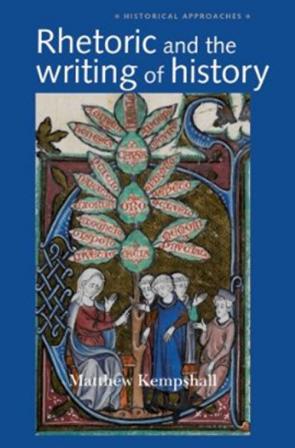
Rhetoric and the Writing of History provides an analytical overview of the vast range of historiography which was produced in western Europe over a thousand-year period between c.400 and c.1500. Concentrating on the general principles of classical rhetoric which informed so much of the language of this writing, alongside the more familiar traditions of ancient history, biblical exegesis and patristic theology, this survey is designed to serve as an introduction to the conceptual sophistication and semantic rigour with which medieval authors could approach their narratives of past and present events. Reviewed by Ignas Kalpokas.
 Rhetoric and the Writing of History, 400-1500. Matthew Kempshall. Manchester University Press. August 2011.
Rhetoric and the Writing of History, 400-1500. Matthew Kempshall. Manchester University Press. August 2011.
Matthew Kempshall’s Rhetoric and the Writing of History introduces the modern reader to the complex and unequivocal world of medieval historiography. Kempshall, a Lecturer in Medieval History at Wadham College, University of Oxford, has produced much more than a book about past practices of writing history; the understanding of how history was written in the past sheds light on present practices by showing that the discipline of history is fundamentally interwoven with the intellectual context of the period in question. One might even say that the essence of history lies outside what one would nowadays instinctively call ‘history proper’. The subject of this volume closely conforms to the major developments in historic method (and social sciences in general): the ‘linguistic turn’, the idea of narratology, and the drive to contextualise meaning.
The book is centred around two main issues: first, as suggested by the title, the close interrelationship between rhetoric and historical narrative, and second, the sources of methodology of history, both Christian and non-Christian (i.e. Greco-Roman).
As Kempshall puts it, the connection between rhetoric and history arose from the fact that the latter was taught in the Middle Ages as part of the trivium, i.e. as part of studies in grammar, rhetoric, and dialectic. Consequently, the understanding of history was determined by the three main functions of rhetoric as laid out by Cicero and Quintilian: to teach, to move, and to please. The writing of history included not only a representation of the past, but also was tailored as a good example for incalculating virtue in the audience and to correct its mores; determination of what is equitable, right and just, that is, an attempt to settle a (usually political) dispute; and to move the public and induce it to act in a particular way, to legitimate power, to establish a community’s sense of shared genealogy and belonging or to ascertain a set of beliefs by illustrating them vividly. Not surprisingly, then, periods of tension, such as the Investiture Conflict, proved to be the most fertile in historiography. Therefore, Kempshall argues, it is incorrect to assume that in order to unearth the ‘real’ history, the superfluous layers and ornamentations of the text have to be removed. On the contrary, rather than perceiving medieval history as more primitive than the modern writings, one should see it as more complex, requiring a holistic approach.
As for the sources, a medieval historiographer had first and foremost Roman authors as models to be followed. These included Sallust, Julius Caesar, Tacitus, Suetonius, Ammianus Marcelinus, and Josephus. Among these, one could find different models of presentation: history as a record of political and military events (Sallust), the history of a city from its beginnings onwards (Livy), individuals’ lives and deeds (Suetonius) etc. In addition to this, the biblical tradition provided completely different forms of speech and interpretation.
Kempshall also deals extensively with what is often perceived as inaccuracy (and therefore inadequacy) of medieval historiography, again arguing for a more benevolent approach. Although deviation from ‘what really happened’ was allowed, it could not be entirely fantastical, and this only adds to the complexity of medieval historical narrative. The narration of what could have happened must have been plausible both in the eyes of the public and in the light of the laws of nature and history. If history had a social, political, and moral function, the accounts of what is believed by a certain community to have happened necessarily had to be included, even if these were not the most reputable parts of a narrative. Likewise, while history had to teach its audience, the narration of events could be tweaked in order to achieve the desired effect. But then again, similarity to truth, adherence to common sense (an a particular audience’s understanding of what counts as common sense), the appropriateness of words and deeds to the persons described, evidence of causal relations, and the presence of motives and opportunities were considered to be vital.
However, Kempshall’s nuanced interpretation means that medieval historiographers cannot be seen as liars or producers of fable. There must be an explicit ethical moment, and it is once again found in the theory of classical rhetoric. Here Quintilian’s emphasis on the moral probity of the speaker or writer and his (almost without exception his) personal responsibility to cultivate his own mores and sense of justice are posed as a safeguard. Therefore, the historiographer himself had to serve as an embodiment and example of the same virtues and qualities he strove to induce. Also, when the deeds of an individual were recounted, responsibility towards the individual concerned, towards the intended community of addressees and the importance of the wider moral, political and religious framework against which one is writing all required a complicated equilibrium to be achieved.
Unlike most volumes that have their origin in a lecture series, this book offers a well-integrated whole rather than a collection of topics. And just like a well-composed lecture, it is clear and accessible, even for a lay reader. If medieval historical narrative was intended to be read in two different ways, allegorically by the educated, and literally by the more general audience, the richness of material Kempshall introduces makes many pejorative interpretations of medieval history writing seem to belong to that vulgar mass. The book is intended to serve as a practical methodological guide and introduction to some of the core issues of medieval historiography, as an index of modern scholarship on the issue, as well as a commentary, interpretation, and discussion of some medieval historical texts. Living up to this promise, Rhetoric and the Writing of History might be of interest not only to students and researchers in the areas of history and historiography but also those with an interest in ideology, nationalism, or philosophy.
——————————————————————————————-
Ignas Kalpokas is a PhD student in Politics at the University of Nottingham, working on a dissertation on Baruch Spinoza, Jacques Lacan, and Carl Schmitt. He holds his Masters degree in Social and Political Critical Theory and Bachelors degree in Politics from Vytautas Magnus University (Lithuania). He has also worked on various educational projects and initiatives. Ignas’ research interests lie in the investigation of interrelated concepts of sovereignty, the state, and the political as well as the formation and maintenance of (national) identities. In addition, his research also involves history, literature, and international relations theory. His preferred theoretical framework is mostly Continental philosophy. Read more reviews by Ignas.







